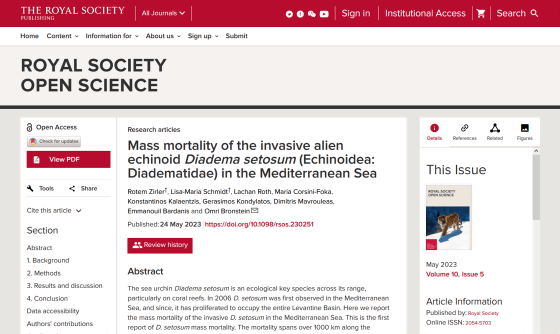There is a possibility that the sea urchin will become only a skeleton and mass death will occur, and the ``gardener'' of the coral reef will disappear and the coral reef will be greatly damaged

In Israel's
Mass mortality of the invasive alien echinoid Diadema setosum (Echinoidea: Diadematidae) in the Mediterranean Sea | Royal Society Open Science
https://doi.org/10.1098/rsos.230251

Within just a few months a deadly epidemic ki | EurekAlert!
https://www.eurekalert.org/news-releases/990130
Mystery pathogen is stripping sea urchins of their flesh and turning them to skeletons — and it's spreading fast | Live Science
https://www.livescience.com/animals/mystery-pathogen-is-stripping-sea-urchins-of-their-flesh-and-turning-them-to-skeletons-and-its-spreading-fast
Gaze is a type of sea urchin characterized by long, thin poisonous needles, and is widely distributed in the Indo-Pacific region, including Japan. In recent years, it has expanded from the Eilat Gulf in the Red Sea to the Mediterranean Sea through the Suez Canal, and in the last 20 years it has increased its population as an invasive species along the Mediterranean coast in northern Israel and southern Turkey.
However, from the beginning of 2023, mass deaths of long-spotted gazelles began to be reported in the Mediterranean Sea, and a few months later, similar mass deaths were confirmed in the Red Sea. Since sea urchins such as Japanese gazelle play an important role in maintaining the health of coral reefs, there are concerns that this situation may affect coral reefs.
A video has been published on YouTube by Dr. Omri Bronstein of Tel Aviv University, who reported on the mass death of Gangaze in the Gulf of Eilat, talking about the problem.
Deadly epidemic killed all the black sea urchins in the Gulf of Eilat - Great threat to the reef - YouTube
Dr. Bronstein's team, which is studying alien species, has been paying attention to Gangaze, which is increasing in population in the Mediterranean Sea.

The gazelle was discovered in southern Turkey in 2006 and on the Mediterranean coast of Israel in 2016, and has experienced an exponential increase in Mediterranean populations since 2018.

However, from the beginning of 2023, mass deaths of longhorns have been reported in the Mediterranean Sea. Eventually, the mass death spread to the Red Sea, and in Eilat Gulf, the long-spotted gazelle became almost extinct.

Gangaze eats excess algae that grow on coral reefs to increase the amount of sunlight that hits the coral and has the role of maintaining the health of coral reefs, so mass death of gangaze may have an adverse effect on coral reefs. Dr. Bronstein said, 'Longfish is considered an important species for the healthy functioning of coral reefs. Sea urchins are the 'gardeners' of coral reefs, feeding on algae that compete with the corals for sunlight, and the algae occupy and suffocate the corals.' 'Unfortunately, they no longer exist in the Gulf of Eilat and are rapidly disappearing further south in the Red Sea.'

When it was first confirmed that the mass deaths of the starfishes in the Eilat Gulf were confirmed, it was speculated that some kind of chemical substance was the cause, as the sea area was close to hotels and industrial areas. However, it was soon reported that the mass deaths were very widespread and that the cause was not limited to some areas. The research team believes that a pathogenic

After the sea urchins were wiped out in the Caribbean, reef algae grew out of control, causing major damage to entire reefs, and there are fears that a similar situation could occur in Eilat Gulf.

A diseased gangaze loses a large amount of tissue within just 48 hours, leaving only the skeleton.

Mass deaths have also spread to gangazes grown in land-based facilities such as university-related laboratories and aquariums. It is believed that this is due to the introduction of pathogens through pumped seawater.

Dr. Bronstein argued that stakeholders need to recognize the seriousness of the situation and act quickly to protect breeding populations of gazelles so that they can be returned to the wild in the future.

Related Posts:







